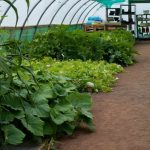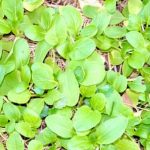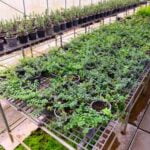Are you interested in growing your own vegetables but don’t have access to a traditional garden space? Container gardening is the perfect solution for those who are limited by space or resources. In this article, we will explore the concept of container gardening and its benefits for growing vegetables in limited spaces, providing a comprehensive guide on how to get started.
Container gardening involves growing plants in containers such as pots, containers, or raised beds, rather than planting them directly in the ground. This method allows individuals with limited outdoor space, such as apartment dwellers or those with small yards, to still enjoy the benefits of homegrown produce. With the right knowledge and techniques, container gardening can be an incredibly rewarding and efficient way to grow vegetables.
In this article, we will discuss the best types of containers for growing vegetables and provide tips on choosing the right vegetables for your space and climate. We will also cover important steps such as preparing the soil, planting and watering techniques, care and maintenance, harvesting tips, and troubleshooting common issues that may arise.
Join us as we delve into the world of container gardening and discover how anyone can grow their own delicious vegetables, no matter how limited their outdoor space may be.
Choosing the Right Containers
When it comes to container gardening for vegetables, choosing the right containers is crucial for the success of your garden. The type of container you use can affect the growth and health of your plants, so it’s important to select the best option for your specific needs. There are a variety of containers to choose from, including pots, containers, and raised beds, each with their own advantages and considerations.
Pots
Pots are a popular choice for container gardening due to their versatility and ease of use. When selecting pots for growing vegetables, opt for ones that are at least 12 inches in diameter, as larger pots provide more root space and stability for the plants. Additionally, ensure that the pots have adequate drainage holes to prevent waterlogging, which can lead to root rot.
Containers
Containers specifically designed for gardening are also great options for growing vegetables. These containers come in various shapes and sizes, allowing you to customize your garden based on your available space. Look for containers made from durable materials like plastic or ceramic and consider factors such as weight (if they need to be moved), insulation (for temperature regulation), and aesthetics (for visual appeal).
Raised Beds
For those with more space or who prefer not to bend down while gardening, raised beds can be an excellent choice for growing vegetables in containers. Raised beds offer good drainage, better soil warmth during cooler periods, and less bending over while tending to your plants. They also provide better control over soil quality and reduce the likelihood of weed invasion.
No matter which type of container you choose for growing vegetables, ensuring proper drainage is essential to avoid waterlogged roots and other issues that may arise from poor soil moisture management. Consider factors such as size, material, mobility, and aesthetics when selecting the right containers for your vegetable garden through container gardening how to grow vegetables practices.
Selecting the Right Vegetables
Container gardening is a great way to grow vegetables in limited spaces, such as balconies, patios, or small yards. When it comes to selecting the right vegetables for container gardening, there are several factors to consider, including the available space and the climate in your area. Here are some tips for choosing the best vegetables for your container garden:
1. Consider the size of your containers: Some vegetables require deeper containers, while others can thrive in shallower pots. Be sure to choose vegetables that are suitable for the size of your containers to ensure they have enough space for their roots to grow.
2. Think about the amount of sunlight: Different vegetables have varying sunlight requirements. Before choosing which vegetables to grow in your container garden, assess the amount of sunlight that the area receives throughout the day. Leafy greens like lettuce and spinach can thrive with less sunlight, while tomatoes and peppers require full sun.
3. Take into account your climate: Certain vegetables are better suited for specific climates. For example, cold-tolerant crops like kale and carrots are ideal for cooler climates, while heat-loving plants such as eggplants and peppers thrive in warmer regions. Consider your local climate when selecting vegetables for your container garden to ensure a successful harvest.
By carefully considering these factors, you can select the best vegetables for your container garden and maximize the potential of your limited growing space. With proper planning and attention to detail, you can enjoy a bountiful harvest of fresh, homegrown produce all season long.
Preparing the Soil
Container gardening is a wonderful way to grow vegetables, especially if you have limited space or poor soil in your yard. Preparing the soil for container gardening is essential for the success of your vegetable plants. The first step is to choose the right type of soil for your containers.
It’s important to use a high-quality potting mix that is specifically designed for container gardening. This type of soil provides excellent drainage and aeration, which are crucial for the health and growth of your vegetables.
When selecting a potting mix for your container garden, look for one that is labeled as “soilless” and contains ingredients such as peat moss, vermiculite, and perlite. These components help the soil retain moisture while still allowing excess water to drain away, preventing root rot and other issues caused by waterlogged soil.
In addition to using a quality potting mix, it’s important to add fertilizer to your soil before planting your vegetables. Since container-grown plants have limited access to nutrients in the ground, they rely on fertilizers for their nutrition needs. Consider using a slow-release fertilizer or organic compost to provide a steady supply of nutrients throughout the growing season. Be sure to follow the instructions on the fertilizer package to avoid over-feeding or burning your vegetable plants.
Properly preparing the soil is crucial for successful container gardening, as it sets the foundation for healthy growth and bountiful harvests. By using high-quality potting mix and adding appropriate fertilizer, you can ensure that your vegetable plants have everything they need to thrive in their contained environment.
| Aspect | Details |
|---|---|
| Type of Soil | High-quality potting mix labeled as “soilless” with peat moss, vermiculite, and perlite |
| Fertilizer | Slow-release fertilizer or organic compost recommended |
Planting and Watering
First, it’s important to choose the right vegetables for your container garden. Some of the best vegetables for container gardening include tomatoes, peppers, lettuce, carrots, radishes, and herbs like basil and parsley. When selecting your vegetables, consider the space available in your containers and the climate in your area. Choose varieties that are well-suited for container growing and that will thrive in your specific environment.
Once you have chosen your vegetables, it’s time to plant them in your containers. Make sure to use quality potting soil that is well-draining but also retains moisture. Proper planting depth is essential, so be sure to follow the specific instructions for each type of vegetable you are growing.
Pay attention to proper spacing between plants to allow for adequate airflow and room for growth. Watering is also a critical aspect of container gardening. The amount of water needed will depend on factors such as the size of the container, the type of plant, and environmental conditions like temperature and humidity.
In terms of watering techniques, it’s important not to overwater or underwater your plants. Overwatering can lead to root rot, while underwatering can result in stunted growth and poor harvests. To determine if your plants need water, stick your finger into the soil – if it feels dry an inch below the surface, it’s time to water.
Water thoroughly until excess water drains out of the bottom of the container. It’s also advisable to water in the morning or evening to reduce evaporation loss during hot daytime temperatures.
| Container Gardening Tips | Data |
|---|---|
| Choose suitable vegetables | Tomatoes, peppers, lettuce; consider space available and climate |
| Planting Techniques | Use quality potting soil; pay attention to proper planting depth; provide adequate spacing between plants |
| Watering Techniques | Avoid overwatering or underwatering; water thoroughly until excess drains; water in morning or evening |
Care and Maintenance
Pest Control
One of the key aspects of maintaining a successful container garden is pest control. Pests like aphids, caterpillars, and beetles can wreak havoc on your vegetable plants if left unchecked. To prevent infestations, regularly inspect your plants for any signs of pests. If you notice any, you can physically remove them or use organic insecticidal soaps to manage the problem. Additionally, introducing beneficial insects such as ladybugs or lacewings can help keep pest populations under control.
Disease Prevention
Diseases can also pose a threat to your container garden. To prevent common diseases like powdery mildew or blight, ensure good airflow around your plants by avoiding overcrowding in your containers. Also, water your plants at the base to keep the foliage dry and reduce the risk of fungal infections. Applying a fungicide according to the product’s instructions can also aid in disease prevention.
Fertilization
Regular fertilization is essential for maintaining healthy vegetable plants in containers. You can use a balanced fertilizer specifically formulated for vegetables or incorporate organic compost into the soil mix to provide essential nutrients. During the growing season, it’s recommended to fertilize every 4-6 weeks to support vigorous growth and maximize yields from your container garden.
By implementing these care and maintenance practices, you can ensure that your container garden thrives and produces an abundance of fresh vegetables for you to enjoy throughout the growing season.
Harvesting and Enjoying
After all the hard work of planting, watering, and caring for your container garden, it’s finally time to reap the rewards. Harvesting vegetables from your container garden can be a truly satisfying experience, as you get to enjoy the fruits of your labor by incorporating fresh, home-grown produce into your meals. Here are some tips for successful harvesting and ways to enjoy the bountiful harvest from your container garden:
1. Timing is Key: When it comes to harvesting vegetables from your container garden, timing is crucial. Each vegetable has its own optimal harvest time, so it’s important to familiarize yourself with the specific harvest window for each type of vegetable you are growing. This will ensure that you pick them at their peak flavor and nutrition.
2. Harvesting Techniques: Different vegetables require different harvesting techniques. Some vegetables like tomatoes or peppers can simply be plucked off the vine when they reach the desired ripeness, while others like lettuce or kale can be harvested by picking individual leaves while allowing the plant to continue growing. Be gentle when harvesting to avoid damaging the plants.
3. Enjoying Your Harvest: There is nothing quite like savoring a meal made with fresh vegetables from your own garden. Whether it’s a simple salad with freshly picked lettuce and tomatoes, or a flavorful stir-fry using home-grown bell peppers and snap peas, enjoying the produce from your container garden is incredibly rewarding. You can also consider preserving any excess harvest through freezing, canning or pickling so that you can enjoy your produce throughout the year.
Container gardening how to grow vegetables is not just about planting and cultivating; it’s also about reaping and relishing in nature’s gift of fresh produce right at your own doorstep.
Troubleshooting Common Issues
In conclusion, container gardening offers a convenient and practical way to grow vegetables, even in limited spaces. By choosing the right containers, selecting the appropriate vegetables, preparing the soil, and providing proper care and maintenance, you can enjoy a bountiful harvest of fresh produce right at your doorstep. However, as with any form of gardening, common problems and challenges may arise that can affect the growth and yield of your plants.
One common issue in container gardening is overwatering or underwatering. It’s important to strike a balance and ensure that your plants receive just the right amount of water to thrive. Another challenge is pest control, as pests can easily infest container gardens. Regular monitoring and using natural pest control methods can help keep these unwanted visitors at bay.
Furthermore, issues like nutrient deficiencies or diseases can also affect the health of your plants. By regularly inspecting your container garden and providing proper nutrients and care, you can address these problems before they become more serious. With the right knowledge and proactive approach to troubleshooting common issues in container gardening, you can ensure a successful harvest of delicious home-grown vegetables.
Frequently Asked Questions
How to Do Container Vegetable Gardening?
Container vegetable gardening involves selecting the right containers, choosing the appropriate soil, and finding a suitable location with adequate sunlight. It’s important to water and fertilize regularly and to pay attention to potential pest and disease issues.
What Is the Easiest Vegetable to Grow in a Container?
One of the easiest vegetables to grow in a container is lettuce. Lettuce doesn’t require a lot of space, has shallow roots, and can thrive in a container with proper care. It’s also quick to mature and can be harvested multiple times.
How Deep Do Containers Need to Be to Grow Vegetables?
The depth of containers needed to grow vegetables varies depending on the specific vegetable being grown. In general, most vegetables need a minimum depth of 12 inches for their root systems to develop properly. Larger plants like tomatoes may require even deeper containers, while herbs can thrive in shallower ones.

If you’re looking to get into vegetable gardening, or are just looking for some tips on how to make your current garden better, then you’ve come to the right place! My name is Ethel and I have been gardening for years. In this blog, I’m going to share with you some of my best tips on how to create a successful vegetable garden.





